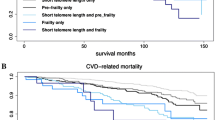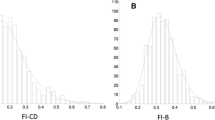Abstract
Frailty is considered a clinical marker of functional ageing. Telomere length (TL) has been proposed as a biomarker of biological age but its role in human ageing is controversial. The main aim of the study was to evaluate the longitudinal association of TL with incident frailty and mortality in two cohorts of Spanish community–dwelling older adults. TL was determined at baseline in blood samples from older adults included in Toledo Study for Healthy Aging and ENRICA cohorts while frailty was determined by frailty phenotype (FP) at baseline and at follow-up (3.5 years). Deaths occurring during follow-up were also recorded. Associations of TL with frailty and mortality were analysed by logistic regression with progressive adjustment. Data were separately analysed in the two cohorts and in all subjects by performing a meta-analysis. TL was not different between frail and non-frail subjects. Longer telomeres were not associated with lower risk of prevalent frailty. Similarly, TL at baseline failed to predict incident frailty (OR: 1.04 [0.88–1.23]) or even the development of a new FP criterion (OR: 0.97 [0.90–1.05]) at follow-up. Lack of association was also observed when analysing the development of specific FP criteria. Finally, while frailty at baseline was significantly associated with higher risk of death at follow-up (OR: 4.08 [1.97–8.43], p < 0.001), TL did not significantly change the mortality risk (OR: 1.05 [0.94–1.16]). Results show that TL does not predict incident frailty or mortality in older adults. This suggests that TL is not a reliable biomarker of functional age.



Similar content being viewed by others
Data availability
Not applicable.
References
United Nations. World population ageing (2019). https://www.un.org/en/development/desa/population/publications/pdf/ageing/WorldPopulationAgeing2019-Highlights.pdf.
Dzau VJ, Inouye SK, Rowe JW, Finkelman E, Yamada T. Enabling healthful aging for all - the National Academy of Medicine Grand Challenge in Healthy Longevity. N Engl J Med. 2019;381:1699–701. https://doi.org/10.1056/NEJMp1912298.
Brivio P, Paladini MS, Racagni G, Riva MA, Calabrese F, Molteni R. From healthy aging to frailty: in search of the underlying mechanisms. Curr Med Chem. 2019;26:3685–701. https://doi.org/10.2174/0929867326666190717152739.
Dent E, Martin FC, Bergman H, Woo J, Romero-Ortuño R, Walston JD. Management of frailty: opportunities, challenges, and future directions. Lancet. 2019;394:1376–86. https://doi.org/10.1016/S0140-6736(19)31785-4.
Angulo J, El Assar M, Rodriguez-Manas L. Frailty and sarcopenia as the basis for the phenotypic manifestation of chronic diseases in older adults. Mol Asp Med. 2016;50:1–32. https://doi.org/10.1016/j.mam.2016.06.001.
Lorenzi M, Bonassi S, Lorenzi T, Giovannini S, Bernabei R, Onder G. A review of telomere length in sarcopenia and frailty. Biogerontology. 2018;19:209–21.
Ferrucci L, Gonzalez-Freire M, Fabbri E, Simonsick E, Tanaka T, Moore Z, et al. Measuring biological aging in humans: a quest. Aging Cell. 2020;19:e13080. https://doi.org/10.1111/acel.13080.
Fasching CL. Telomere length measurement as a clinical biomarker of aging and disease. Crit Rev Clin Lab Sci. 2018;55:443–65. https://doi.org/10.1080/10408363.2018.1504274.
Cawthon RM, Smith KR, O'Brien E, Sivatchenko A, Kerber RA. Association between telomere length in blood and mortality in people aged 60 years or older. Lancet. 2003;361:393–5. https://doi.org/10.1016/S0140-6736(03)12384-7.
El Assar M, Angulo J, Rodríguez-Mañas L. Frailty as a phenotypic manifestation of underlying oxidative stress. Free Radic Biol Med. 2020;149:72–7. https://doi.org/10.1016/j.freeradbiomed.2019.08.011.
Yu R, Tang N, Leung J, Woo J. Telomere length is not associated with frailty in older Chinese elderly: cross-sectional and longitudinal analysis. Mech Ageing Dev. 2015;152:74–9. https://doi.org/10.1016/j.mad.2015.10.002.
Breitling LP, Saum KU, Perna L, Schottker B, Holleczek B, Brenner H. Frailty is associated with the epigenetic clock but not with telomere length in a German cohort. Clin Epigenetics. 2016;8:21. https://doi.org/10.1186/s13148-016-0186-5.
Ortiz-Ramírez M, Sánchez-García S, García-De la Torre P, Reyes-Maldonado E, Sánchez-Arenas R, Rosas-Vargas H. Telomere shortening and frailty in Mexican older adults. Geriatr Gerontol Int. 2018;18:1286–92. https://doi.org/10.1111/ggi.13463.
Vetter VM, Spira D, Banszerus VL, Demuth I. Epigenetic clock and leukocyte telomere length are associated with vitamin D status, but not with functional assessments and frailty in the Berlin Aging Study II. J Gerontol A Biol Sci Med Sci. 2020; (On-line ahead of print). https://doi.org/10.1093/gerona/glaa101.
García-García FJ, Gutiérrez Avila G, Alfaro-Acha A, et al. The prevalence of frailty syndrome in an older population from Spain. The Toledo Study for Healthy Aging. J Nutr Health Aging. 2011;15:852–6. https://doi.org/10.1007/s12603-011-0075-8.
Sánchez-Sánchez JL, Izquierdo M, Carnicero-Carreño JA, García-García FJ, Rodríguez-Mañas L. Physical activity trajectories, mortality, hospitalization, and disability in the Toledo Study of Healthy Aging. J Cachexia Sarcopenia Muscle. 2020; (On-line ahead of print). https://doi.org/10.1002/jcsm.12566.
Rodríguez-Artalejo F, Graciani A, Guallar-Castillón P, León-Muñoz LM, Zuluaga MC, López-García E, et al. Rationale and methods of the study on nutrition and cardiovascular risk in Spain (ENRICA). Rev Esp Cardiol. 2011;64:876–82. https://doi.org/10.1016/j.recesp.2011.05.019.
Ortolá R, Struijk EA, García-Esquinas E, Rodríguez-Artalejo F, López-García E. Changes in dietary intake of animal and vegetable protein and unhealthy aging. Am J Med. 2019;132:1091–102. e9. https://doi.org/10.1016/j.amjmed.2019.06.051.
Fried LP, Tangen CM, Walston J, Newman AB, Hirsch C, Gottdiener J, et al. Frailty in older adults: evidence for a phenotype. J Gerontol A Biol Sci Med Sci. 2001;56:M146–56. https://doi.org/10.1093/gerona/56.3.m146.
Ottenbacher KJ, Branch LG, Ray L, Gonzales VA, Peek MK, Hinman MR. The reliability of upper- and lower-extremity strength testing in a community survey of older adults. Arch Phys Med Rehabil. 2002;83:1423–7. https://doi.org/10.1053/apmr.2002.34619.
Guralnik JM, Simonsick EM, Ferrucci L, Glynn RJ, Berkman LF, Blazer DG, et al. A short physical performance battery assessing lower extremity function: association with self-reported disability and prediction of mortality and nursing home admission. J Gerontol. 1994;49:M85–94. https://doi.org/10.1093/geronj/49.2.m85.
Washburn RA, Smith KW, Jette AM, Janney CA. The physical activity scale for the elderly (PASE): development and evaluation. J Clin Epidemiol. 1993;46:153–62. https://doi.org/10.1016/0895-4356(93)90053-4.
Katz S, Ford AB, Moskowitz RW, Jackson BA, Jaffe MW. Studies of illness in the aged. The index of ADL: a standardized measure of biological and psychosocial function. JAMA. 1963;185:914–9. https://doi.org/10.1001/jama.1963.03060120024016.
de Pedro N, Díez M, García I, García J, Otero L, Fernández L, et al. Analytical Validation of Telomere Analysis Technology® for the high-throughput analysis of multiple telomere-associated variables. Biol Proced Online. 2020;22:2. https://doi.org/10.1186/s12575-019-0115-z.
Cawthon RM. Telomere measurement by quantitative PCR. Nucleic Acids Res. 2002;30:e47. https://doi.org/10.1093/nar/30.10.e47.
O'Callaghan NJ, Fenech M. A quantitative PCR method for measuring absolute telomere length. Biol Proced Online. 2011;13:3. https://doi.org/10.1186/1480-9222-13-3.
Viechtbauer W. Conducting meta-analyses in R with the metafor package. J Stat Softw. 2010;36:1–48. https://doi.org/10.18637/jss.v036.i03.
Muezzinler A, Zaineddin AK, Brenner H. A systematic review of leukocyte telomere length and age in adults. Ageing Res Rev. 2013;12:509–19. https://doi.org/10.1016/j.arr.2013.01.003.
Blackburn EH, Epel ES, Lin J. Human telomere biology: a contributory and interactive factor in aging, disease risk, and protection. Science. 2015;350:1193–8. https://doi.org/10.1126/science.aab3389.
Svensson J, Karlsson MK, Ljunggren O, Tivesten A, Mellstrom D, Moverare-Skrtic S. Leukocyte telomere length is not associated with mortality in older men. Exp Gerontol. 2014;57:6–12. https://doi.org/10.1016/j.exger.2014.04.013.
Needham BL, Rehkopf D, Adler N, Gregorich S, Lin J, Blackburn EH, et al. Leukocyte telomere length and mortality in the National Health and Nutrition Examination Survey, 1999-2002. Epidemiology. 2015;26:528–35. https://doi.org/10.1097/EDE.0000000000000299.
Woo J, Yu R, Tang N, Leung J. Telomere length is associated with decline in grip strength in older persons aged 65 years and over. Age (Dordr). 2014;36:9711. https://doi.org/10.1007/s11357-014-9711-7.
Risques RA, Arbeev KG, Yashin AI, Ukraintseva SV, Martin GM, Rabinovitch PS, et al. Leukocyte telomere length is associated with disability in older U.S. population. J Am Geriatr Soc. 2010;58:1289–98. https://doi.org/10.1111/j.1532-5415.2010.02948.x.
Marzetti E, Lorenzi M, Antocicco M, Bonassi S, Celi M, Mastropaolo S, et al. Shorter telomeres in peripheral blood mononuclear cells from older persons with sarcopenia: results from an exploratory study. Front Aging Neurosci. 2014;6:233. https://doi.org/10.3389/fnagi.2014.00233.
Saum KU, Dieffenbach AK, Muezzinler A, et al. Frailty and telomere length: cross-sectional analysis in 3537 older adults from the ESTHER cohort. Exp Gerontol. 2014;58:250–5. https://doi.org/10.1016/j.exger.2014.08.009.
Zhou J, Wang J, Shen Y, Yang Y, Huang P, Chen S, et al. The association between telomere length and frailty: a systematic review and meta-analysis. Exp Gerontol. 2018;106:16–20. https://doi.org/10.1016/j.exger.2018.02.030.
Wang Q, Zhan Y, Pedersen NL, Fang F, Hagg S. Telomere length and all-cause mortality: a meta-analysis. Ageing Res Rev. 2018;48:11–20. https://doi.org/10.1016/j.arr.2018.09.002.
Gardner MP, Martin-Ruiz C, Cooper R, Hardy R, Sayer AA, Cooper C, et al. Telomere length and physical performance at older ages: an individual participant meta-analysis. PLoS One. 2013;8:e69526. https://doi.org/10.1371/journal.pone.0069526.
Haapanen MJ, Perala MM, Salonen MK, et al. Telomere length and frailty: the Helsinki Birth Cohort study. J Am Med Dir Assoc. 2018;19:658–62. https://doi.org/10.1016/j.jamda.2018.05.011.
Diez Roux AV, Ranjit N, Jenny NS, Shea S, Cushman M, Fitzpatrick A, et al. Race/ethnicity and telomere length in the Multi-Ethnic Study of Atherosclerosis. Aging Cell. 2009;8:251–7. https://doi.org/10.1111/j.1474-9726.2009.00470.x.
Araujo Carvalho AC, Tavares Mendes ML, da Silva Reis MC, Santos VS, Tanajura DM, Martins-Filho PRS. Telomere length and frailty in older adults-a systematic review and meta-analysis. Ageing Res Rev. 2019;54:100914. https://doi.org/10.1016/j.arr.2019.100914.
Arts MHL, Collard RM, Comijs HC, de Jonge L, Penninx BWJH, Naarding P, et al. Leucocyte telomere length is no molecular marker of physical frailty in late-life depression. Exp Gerontol. 2018;111:229–34. https://doi.org/10.1016/j.exger.2018.07.016.
Zhan Y, Liu XR, Reynolds CA, Pedersen NL, Hagg S, Clements MS. Leukocyte telomere length and all-cause mortality: a between-within twin study with time-dependent effects using generalized survival models. Am J Epidemiol. 2018;187:2186–91. https://doi.org/10.1093/aje/kwy128.
Martin-Ruiz CM, Gussekloo J, van Heemst D, von Zglinicki T, Westendorp RG. Telomere length in white blood cells is not associated with morbidity or mortality in the oldest old: a population-based study. Aging Cell. 2005;4:287–90. https://doi.org/10.1111/j.1474-9726.2005.00171.x.
Rodríguez-Mañas L, Féart C, Mann G, Viña J, Chatterji S, Chodzko-Zajko W, et al. Searching for an operational definition of frailty: a Delphi method based consensus statement: the frailty operative definition-consensus conference project. J Gerontol A Biol Sci Med Sci. 2013;68:62–7. https://doi.org/10.1093/gerona/gls119.
Fitzpatrick AL, Kronmal RA, Kimura M, Gardner JP, Psaty BM, Jenny NS, et al. Leukocyte telomere length and mortality in the Cardiovascular Health Study. J Gerontol A Biol Sci Med Sci. 2011;66:421–9. https://doi.org/10.1093/gerona/glq224.
Gladyshev VN. Aging progressive decline in fitness due to the rising deleteriome adjusted by genetic, environmental, and stochastic processes. Aging Cell. 2016;15:594–602. https://doi.org/10.1111/acel.12480.
Galkin F, Mamoshina P, Aliper A, de Magalhaes JP, Gladyshev VN, Zhavoronkov A. Biohorology and biomarkers of aging: current state-of-the-art, challenges and opportunities. Ageing Res Rev. 2020;60:101050. https://doi.org/10.1016/j.arr.2020.101050.
Acknowledgments
We appreciate the altruistic contribution of the participants from the Toledo Study for Healthy Aging cohort and ENRICA cohort.
Funding
This work has received funding from the European Union’s Seventh Framework Programme (FP7/2007-2013) under grant agreement number 305483 and was supported by grants from the Ministry of Economy and Competitiveness and co-financed by FEDER funds (Instituto de Salud Carlos III, PI15/00674, PI15/01160) and CIBERFES (CB16/10/00464), Spanish Government.
Author information
Authors and Affiliations
Contributions
MEA, JA, JAC, SW, FRA and LRM participated in conceptualization and design of the study; MEA, JA, JAC, SW, JGM, IGP, FLGG, FRA and LRM performed data acquisition analysis and interpretation; MEA, JA, JAC, SW, FRA and LRM wrote the original draft of the manuscript; all authors reviewed, edited and approved the final version of the manuscript.
Corresponding author
Ethics declarations
Conflict of interest
The authors declare that they have no conflict of interest.
Ethics approval
The study protocols were approved by the Clinical Research Ethics Committee of the Complejo Hospitalario de Toledo (Toledo Study for Healthy Aging cohort), and by the Clinical Research Ethics Committee of the ‘La Paz’ University Hospital in Madrid (ENRICA cohort).
Consent to participate
All participants gave written informed consent to participate.
Code availability
Not applicable.
Additional information
Publisher’s note
Springer Nature remains neutral with regard to jurisdictional claims in published maps and institutional affiliations.
About this article
Cite this article
El Assar, M., Angulo, J., Carnicero, J.A. et al. Association between telomere length, frailty and death in older adults. GeroScience 43, 1015–1027 (2021). https://doi.org/10.1007/s11357-020-00291-0
Received:
Accepted:
Published:
Issue Date:
DOI: https://doi.org/10.1007/s11357-020-00291-0




